Dialogue | Wu Changshuo’s great-grandson talks about his great-grandfather and Shanghai: the power of the stone, the heart of the grass.
"Jin Shili Grass Heart-Wu Changshuo and Shanghai" has been exhibited at the China Art Palace (Shanghai Art Museum) since February 10, 2021. The exhibition focuses on the relationship between Wu Changshuo and Shanghai-style art and Shanghai. For the first time, it has gathered from Shanghai Museum, Zhejiang Museum, Hangzhou Xiling Printing Society, (Anji) Wu Changshuo Memorial Hall, Shanghai Wu Changshuo Memorial Hall, Shanghai China Painting Academy and their families. From Wu Changshuo’s 23-year-old seal script and his 36-year-old plum blossom painting to his masterpiece in his later years, we can also see how Wu Changshuo’s stone brush runs through, and also see Wu Changshuo’s friends and artistic life.
"The Paper Art Review" (www.thepaper.cn) recently talked with Wu Changshuo’s great-grandchildren Wu Chao and wuyue, who are currently the directors of Shanghai Wu Changshuo Culture and Art Foundation and the executive curator of Wu Changshuo Memorial Hall respectively. Their father Wu Changye is the child held by Wu Changshuo in the well-known old photo of Wu Changshuo’s family portrait, and they also grew up listening to Wu Changshuo’s story, but now they have changed from storytellers to storytellers.

Wu Changshuo and his son Wu Dongmai, and their granddaughters Wu Diying and Sun Wu Changye (holding hands) took a group photo.
Wu Changshuo and Shanghai
The Paper: In this special exhibition "Wu Changshuo and Shanghai", the works are borrowed from Shanghai Museum, Zhejiang Museum, Xiling Press and many other cultural institutions. Many works are also exhibited in Shanghai for the first time. Is there any emphasis on the selection of exhibition works?
Wu Chao:The preparation time for this exhibition is relatively tight, and we have received strong support from Xiling Printing House, Zhejiang Museum, Shanghai Museum, Shanghai Wu Changshuo Memorial Hall and Shanghai China Painting Academy. Some of the works on display were donated by our family to Xiling Printing House and Zhejiang Museum. As members of Xiling Printing House, our family will donate some collections to Xiling Printing House and all the places where Wu Changshuo Memorial Hall was established, from which we can see the support of the Wu family, who has spanned four generations, to the memorial sites in Wu Changshuo.
In this exhibit, some of Wu Changshuo’s poems and letters are on public display for the first time, including the eight-meter-long regular script and scroll landscape paintings collected by Zhebo. Even more, Mr. Wang Yiting painted Xiang sister for Wu Changshuo, and Mr. Wu made a long topic about this painting, from which we can see that Mr. Wu Changshuo has always had deep feelings for his hometown and childhood from his youth to his success, and his works are always full of such rich humanistic spirit.

Wu Changshuo, Xiang sister, 1927, private collection.
Wuyue:Many people think of Mr. Wu Changshuo as a flower painter. But in fact, his paintings are very extensive. In this exhibition, you can see animals such as tigers, cranes and deer, as well as figure paintings and landscape paintings written by Mr. Wu Changshuo. The calligraphy on display includes Mr. Wu Changshuo’s calligraphy works from the age of 23 to 84, while the paintings are from the age of 36 to 84. The content of calligraphy style is also very rich, such as Zhang Caoli seal and stone drum.

Han Juan of Landscape Poems, 1919, Zhejiang Provincial Museum.

Han Juan of Landscape Poems, 1919, Zhejiang Provincial Museum.

Han Juan of Landscape Poems, 1919, Zhejiang Provincial Museum.
Zhejiang Museum will lend some of its collections for free this time. When we select exhibits, we pay attention to few but fine, and cover a wide range, so that everyone can feel the comprehensiveness of Mr. Wu Changshuo’s art. In addition to calligraphy and painting, there are also letters and Four Treasures of the Study. The coverage and span of this exhibition can be said to be unprecedented. The exhibits we chose this time are also rare works. Take advantage of the momentum of the first exhibition of the Year of the Ox in the Chinese Art Palace, carry forward the spirit of Wu Changshuo, inspire the people through culture, and let everyone feast their eyes.

Wu Changshuo, "The Wind and Cloud Map of Lingao Qipei Xiao Juan" (Axis), collected in Zhejiang Provincial Museum in 1898.

Wu Changshuo, Cat (Axis), 1896, private collection.
The Paper: The exhibition is called "Wu Changshuo and Shanghai". What did Shanghai bring to Wu Changshuo and what did Wu Changshuo bring to Shanghai?
Wuyue:Mr. Wu Changshuo and Pudong have an indissoluble bond with Shanghai, where he made friends such as Li Pingshu and Chen Guichun, and also participated in the establishment of Oriental Hospital. As an artist, he not only guided the development of Shanghai culture in the art field, but also had a strong humanistic spirit.
One of the works in the exhibition, Peony Flower, is a collection of Anji Wu Changshuo Memorial Hall. This work is related to Pudong. Around 1900, Wu Changshuo often went to Pudong flower garden to watch flowers, and when he returned home, he spread paper and painted them. Peony and peony written by Wu Changshuo were commonly known as "local flowers" by Shanghainese. Last year was the 30th anniversary of Pudong’s development and opening-up, and we also held the activity of "130th anniversary of Wu Changshuo’s attachment to Pudong", so we borrowed this work.

Wu Changshuo, Flower Map of Peony in Pudong, 1894, (Anji) Wu Changshuo Memorial Collection.
In 1909, Wu Changshuo, Mr. Qian Huian and Mr. Wang Yiting founded the Yuyuan Garden Calligraphy and Painting Society, which was the first charity organization in Shanghai painting circle. We can know from the recent historical materials that Mr. Chang Shuo provided support for the May 30th Movement under the leadership of the Communist Party of China. He also trained a large number of outstanding disciples in Jiqingli on the northwest road of Shanghai Mountain. In this narrow world, he has walked out of Pan Tianshou, Liu Haisu, Wang Geyi and other famous figures in the field of calligraphy and painting seal cutting. Mei Lanfang and Xun Huisheng once worshipped him. Mr. Wu Changshuo is engaged in artistic creation and training his disciples in Shanghai, a land full of rivers and seas. The disciples spread his thoughts and made positive contributions to cultural development.

Wu Changshuo, Li Shu Si Yan Lian, 1927, collected by Xiling Press.
Wu Chao:Shanghai provides Mr. Wu Changshuo with a creative platform. At that time, Shanghai style painting and calligraphy were divided into "pre-Shanghai style" and "post-Shanghai style". In the late Qing Dynasty, the "Pre-Shanghai School" prevailed, which was characterized by exquisite brushwork of calligraphy and painting. After the Revolution of 1911, the emperors from Beijing and other former literati left for the south, bringing a "golden stone wind". Wu Changshuo’s poetry, calligraphy and painting are all printed, and his painting style comes from "printing", including his evolution of Shi Guwen into a stone drum body with his own style, and his paintings are painted with Shi Guwen’s calligraphy lines, so his paintings are the best embodiment of the golden stone flavor, which confirms the theme of our exhibition-"Golden Stone Power".

Wu Changshuo, Lin San’s Disc (Lens), 1922, Wu Changshuo Memorial Collection.
Wu Changshuo is a native of Zhejiang. Among Shanghai painters, there are very few real local painters in Shanghai. It is precisely because Shanghai is full of rivers that artists from all over the world gather together. At that time, Wang Yiting invited Wu Changshuo to Shanghai. At this time, foreign cultures in Shanghai also entered in large quantities and became an international platform. After Mr. Wu Changshuo arrived at this open platform, he was more able to display his ability and push the art of Shanghai style to the international market.

Wu Changshuo, "The Orchid Map of Dieshi" (Axis), 1921, private collection.
The Paper: Wu Changshuo is in an era of cultural transformation between the old and the new. How are the old and new cultures reflected in Wu Changshuo’s life and paintings?
Wu Chao:Wu Changshuo’s "poetry, calligraphy and painting" is mainly the traditional culture of China. Wu Changshuo first learned Zhong You’s lower case calligraphy, and Mr. Pan Tianshou said that Wu Changshuo could still write lower case calligraphy when he was 80 years old. His regular script also contains his "golden stone spirit" The "golden stone spirit" comes from his study of steles. After thousands of years of weathering and time-making, the words carved on stones have been worn away and full of charm. Mr. Wu Changshuo incorporated this flavor into his calligraphy. But he does not exclude foreign cultures. Western red pigments and oil painting techniques have been used in his paintings. We can see that his painting style is as thick and realistic as oil painting. As long as he thinks it is good, he will absorb it both at home and abroad, and continue to learn and improve his art.

Wu Changshuo, Drunk Zhong Kui Map (Partial), 1921, Zhejiang Provincial Museum.

Wu Changshuo’s account book-pen and ink career
The Paper: Wu Changshuo met Ren Bonian, Wu Dacheng, Wang Yiting and others in Shanghai. What influence did they have on Wu Changshuo?
Wu Chao:At the age of 40, Wu Changshuo met Ren Bonian under the introduction of Gao Zhizhi. Ren Bonian and Wu Changshuo are five years apart, almost equal in age. At that time, Ren Bonian was famous in the painting world, and Wu Changshuo asked him for advice on painting. Before that, Wu Changshuo had begun to learn painting. This time, four plum blossoms painted at the age of 36 were exhibited, which is one of the earliest paintings in Wu Changshuo. At the age of 30, Mr. Wu Changshuo began to learn to draw plum blossoms with his country teacher Pan Zhifu. He loved plum blossoms all his life, and the plum blossoms he painted were elegant and natural. When meeting Ren Bonian, Ren Bonian asked him to draw a few strokes at will by writing. As soon as Wu Changshuo started to write, Ren Bonian told him that if he continued to draw with this brushwork, he would achieve something. So Wu Changshuo has been following the path that Mr. Ren Bonian pointed out for him.

Wu Changshuo, Mo Mei Album III, 1879, private collection.
Mr. Wu Dacheng, an official in the late Qing Dynasty, was also a collector, who helped Wu Changshuo a lot. When Mr. Chang Shuo was in his thirties and forties, he often went to some collectors’ homes to teach. On the one hand, he also arranged cultural relics for his master’s family and learned a lot. There is a work "Deng Mei" in this exhibit, which is inscribed with Wu Dacheng’s seal script. The main idea is to talk with Mr. Wu Changshuo about poetry and painting, which is quite insightful and they have deep feelings. Wu Changshuo also participated in the Sino-Japanese War of 1894-1895 as the staff of Mr. Wu Dacheng, and wrote many indignant patriotic poems.

Western Zhou Dynasty’s Sanskrit Inscription (Axis), 1918, private collection.

Wu Changshuo, Deng Mei Tu (Axis), 1891, private collection.
Wang Yiting is a teacher and friend to Wu Changshuo. He takes care of Mr. Wu Changshuo wholeheartedly and meticulously, and even helps him arrange some trivial matters in life. In this exhibition, there are several works painted by Chang Shuo and inscribed by Wang Yiting. One of the "Crossing Time and Space" works, "Looking at a Picture of a Man Walking", is very unique. Ren Bonian painted bamboo, Wang Yiting painted people, and Wu Changshuo wrote an inscription. Mr. Ren Bonian painted the bamboo first. Twenty years after his death, his daughter asked Wang Yiting to finish this ink. Mr. Wang Yiting added a portrait of Mr. Chang Shuo enjoying the cool summer night behind the bamboo, with a cattail leaf fan in his hand. The artistic conception of ink painting was quite empty and quiet. After receiving this work, Mr. Chang Shuo was very happy, so he wrote a long title on it to show the friendship between the three people. There is also a flower-and-bird painting, which is also the last ink of Mr. Ren Bonian’s bamboo painting. Twenty years later, Mr. Wang Yiting made up a turtle dove and morning glory, and Wu Changshuo wrote an inscription, which was very clever.

Ren Bonian, Wang Yiting’s Paintings, and Wu Changshuo’s Inscriptions, "A Picture of a Wandering Man" (Axis), 1914, private collection.
The Paper: Wu Changshuo also has contacts with many younger generations. What is his influence on young painters?
Wu Chao:During his stay in Shanghai, Mr. Wu Changshuo also likes to associate with the younger generation and learn new information from them. At that time, the students he coached were Liu Haisu, Pan Tianshou, etc., all in their twenties, and most of them were two generations apart from him. But he never puts on airs because of his qualifications, so young people are willing to come to him to study.
Wuyue:Mr. Wu Changshuo has a pair of couplets written to Pan Tianshou: "It’s amazing to see the writing, and the gossip always goes into poetry", which contains his requirements for his disciples’ art and manners. At the same time, he also believes that his disciples should not imitate him in their creation, but should form their own style and spirit, and they must have their own personality in art in order to make vibrant and shocking works. The name of the exhibition "Jin Shi Li Cao Mu Xin" also comes from Mr. Wu Changshuo’s couplet "Eating Jin Shi Li Nourishing Cao Mu Xin" given to disciple Wang Geyi. "Cao Mu" refers to the common people, and it is hoped that students will follow the mass line, do not let their works be divorced from life, and take the life content of the common people as the theme of art, which is also the direction of Mr. Chang Shuo’s education.

Wu Changshuo, five-character couplet of running script, 1922, collected by Xiling Press.
Wu Changshuo and Painting
The Paper: Pan Tianshou’s "History of Painting in China" said that "Anji Wu Yong Lu Chang Shuo, … learned from the study of stone inscriptions and seals, was a leader of the post-Shanghai school", and how did Pan Tianshou’s "bold and unpretentious, disobedient" reflect in his works?
Wu Chao:Mr. Wu Changshuo is a farmer and knows that hibiscus is a woody plant. However, in "Careless", the hibiscus is a vine. He described the beautiful posture of the imaginary hibiscus, and it seems that the flowers are fluttering on the paper. Under the cursive rattan style, the colors and elements of the flower core are rich and varied. His creation comes from life, but he is not bound by the rules in life. Art comes from life, higher than life, boldly put pen to paper and carefully tidy up.

Wu Changshuo, careless (axis), 1926, private collection.
The statue of Dharma is the largest figure painting in Mr. Wu Changshuo’s works, with great momentum. The most wonderful thing in this work is the pen for clothes. Seeing the picture, it seems that you can imagine Mr. Wu Changshuo’s painting appearance in one go.

Wu Changshuo, The Statue of Dharma (Axis), 1910, private collection.
The Paper: "Stone painting style" is the embodiment of Wu Changshuo’s integration of "poetry, calligraphy and printing". How does this connect with the literati painting tradition?
Wu Chao:Before the end of Qing dynasty, the painting was single in color and elegant in color. However, plain colors can’t suppress the lines with strong atmosphere. Wu Changshuo likes to use strong colors of red, big and green to make the painting more energetic. Therefore, Wu Changshuo’s paintings are called freehand brushwork, which brings a fresh atmosphere to the art market. This style usually implies great wealth and great wealth, and it is very popular with some wealthy families. In this exhibition, there is an account book of Mr. Wu Changshuo, which records his daily income, which was very considerable at that time. His "poems, calligraphy and paintings" are all available, and people who come to the door to seek genuine works are in an endless stream, even deeply loved by some Japanese collectors. Compared with the poor living environment of previous painters, the status of Shanghai painters has been improved.

Wu Changshuo, Photo courtesy of the Qing Dynasty, 1891, Shanghai Wu Changshuo Memorial Collection.
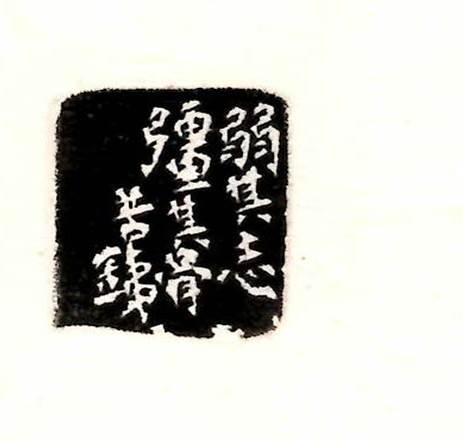
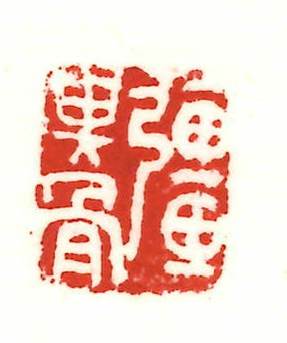
Wu Changshuo, Qiang Qi Gu seal, 1910, 2.1cmx1.8cmx2.4cm, private collection.
Wuyue:Mr. Wu Changshuo earned a considerable income when he was alive. His early years of struggle were quite hard, and he made great progress in his later years, but his life was still simple and rigorous. There is no villa, no mahogany furniture at home, and the husband and wife are respectful. Behind him, all his possessions were basically donated to the society. In 1930, Mr. Wu Changshuo’s son, Wu Dongmai, and friends in the art world initiated the establishment of "Changming Art College" to commemorate Wu Changshuo, which trained many students. Pan Tianshou, Liu Haisu and Wang Geyi all served as teachers in this school. This school was once the activity stronghold of the underground party of the Communist Party of China, which my grandfather Wu Dongmai himself never mentioned. It was only through the memoirs of the underground workers of the party that I learned that he had served communist party in a low-key manner through his special status.
The Paper: Wu Changshuo’s influence on Shanghai painting and culture, and how is Wu Changshuo’s spirit passed down at present?
Wu Chao:Wu Changshuo’s works are always new. In some calligraphy works, we can also see traces of smearing and modification, and we can get a glimpse of his creative process. He has traditional roots in his heart, so his works can be inherited and developed. Looking at Wu Changshuo’s works in his twenties to eighties, we can also see a long and continuous life track with a series of struggles. Wu Changshuo stepped out of everyone’s path step by step. Many painters and painters abandon the foundation in their pursuit of novelty, and their works, even if popular, are only a flash in the pan. Therefore, the so-called innovation is based on the roots. Only by slowly and steadily studying hard in the tradition can we develop our own art.

Six screens of flowers at the exhibition site, 1899, Zhejiang Museum.
Wuyue:From Wu Changshuo’s work and study experience, we can learn three spirits. The first is the humanistic spirit, which is the spirit of not being afraid of difficulties and making progress. In this exhibition, you will see that the inkstone used by one party, Mr. Wu Changshuo, is actually just an ordinary brick. Mr. Chang Shuo’s study and living environment in Anji in his early years was difficult. He had no money to buy inkstones, dug out the wall bricks and carved them himself, and one of them was almost worn out. He overcame many difficulties in his artistic path, and finally he succeeded. These inkstones have been passed down to our generation from my father. He said that the inkstones themselves are worthless, but they inherit the spirit of creating conditions without conditions. We put it on display in the exhibition, and also displayed the spirit of the times of the old gentleman who is not afraid of difficulties and dangers, encouraging the younger generation to struggle hard. This spirit will always have the vitality of the Chinese nation. We hope to tell the story of Mr. Wu Changshuo to young people through the exhibition, and tell the correct ideas to overcome difficulties.

A small audience at the exhibition site is looking at the inkstone carved by Wu Changshuo.
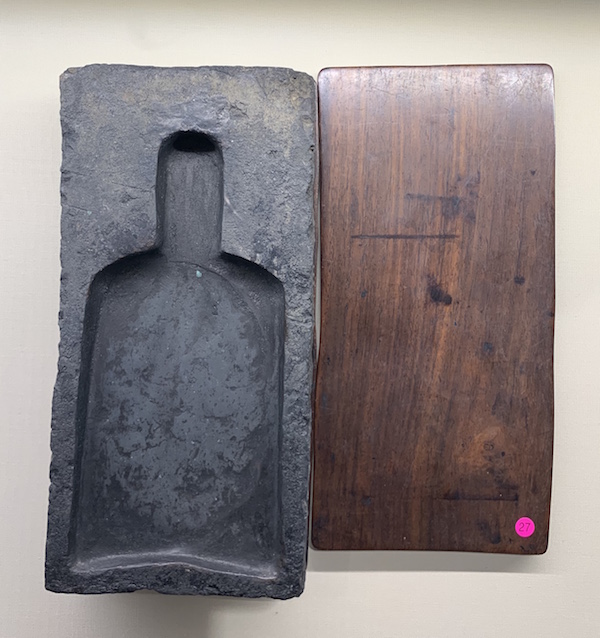
Wu Changshuo carved bricks and inkstones by himself.
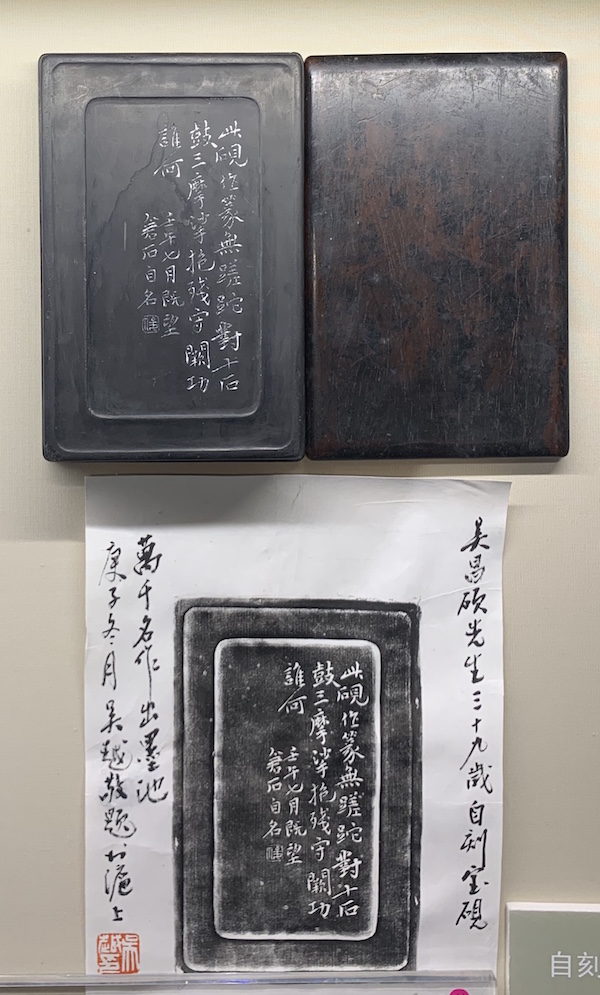
Wu Changshuo carved bricks and inkstones by himself.
Mr. Wu Changshuo also has an indissoluble bond with Pudong, which was a rural area before the development and opening up, but upheld the concept of striving for progress. Nowadays, Pudong is prosperous and has developed a new look of weather. Mr. Chang Shuo also promotes our national spirit through the humanistic spirit in his works of art.
The second is the exploration spirit of "being a disciple with the past and being new with the past", laying a foundation, innovating again and showing a new look of art. The exhibition of China Art Palace is so rich in content, with complete prints of poems, calligraphy and paintings, landscape figures, flowers and animals. Wu Changshuo thought that "the ancients were the guests and I were the mainstay", and on the basis of "being a disciple of the ancients", he achieved "being new with the ancients". Mr. Wu Changshuo likes to create on simple things such as Han bricks and tiles. Everything can be painted in life, and everything can be used for painting, turning antiquities into his own art.

The study room used by Wu Changshuo at the exhibition site.

Wu Changshuo self-use stationery.
The third is the spirit of learning. From his early years, Mr. Wu Changshuo traveled half of China on two legs. At that time, the traffic conditions and communication environment were inconvenient and the situation was unstable. Under such difficult conditions, wherever there are famous teachers, he goes to study, absorbing water like a sponge and turning the advantages of famous teachers into his own things. He traveled all over Huzhou, Hangzhou, Suzhou, Nanjing, Beijing … He learned knowledge with tenacious will. In his later years, he drew motivation from his young friends and lived to learn.

Wu Changshuo, 75.
Wu Changshuo studies.
The Paper: Both China and Japan have studies on Wu Changshuo. Do they have their own emphases?
Wu Chao:Since the reform and opening up in China, the Party and the government have attached great importance to Wu Changshuo’s research and cultural education. Japan’s research on Wu Changshuo has never been interrupted, but most of Wu Changshuo’s works in Japan are created in his later years, and almost none in his early years. Do they want to study Mr. Wu Changshuo’s artistic trajectory systematically and completely, or do they need to rely on China’s materials?

Wu Changshuo’s "Memetu" collected by Tokyo National Museum comes from Qingshan Sugiyama (non-exhibit).
Wuyue:Mr. Wu Changshuo made many Japanese friends and trained a group of Japanese disciples. Through their publicity in Japan, Wu Changshuo’s art entered Japanese textbooks. The proportion of Mr. Wu Changshuo’s works is quite high in Japanese art textbooks from the fourth grade of primary school to graduate students in universities. This is the spread of the excellent traditional culture of our Chinese nation. In 1996, Kyushu also established the Wu Changshuo bust monument. In early 2018, the Tokyo National Museum, Shudao Museum and asakura Sculpture Museum jointly held the exhibition "Wu Changshuo and His Times". Just this year, the Palace Museum in Beijing held a special exhibition of Wu Changshuo’s calligraphy and painting seal cutting in the Palace Museum. In the same year, two national museums in China and Japan held the Wu Changshuo Exhibition, which had great influence. As his descendants, we participated in and supported him all the time.

Poster of "Wu Changshuo and His Times" Exhibition in Tokyo, Japan
The Paper: At present, Wu Changshuo has memorial halls in Shanghai and Anji, as well as Wu Changshuo’s former residence in his hometown of Zhen Wu and Shanghai Jiqingli. What is the current preparation for Jiqingli’s former residence? What is the main responsibility of Wu Changshuo Culture and Art Foundation?
Wuyue:Wu Changshuo Memorial Hall in Pudong is a protected building, which is being repaired recently. The renovation of Wu Changshuo’s former residence on Shanxi North Road has also been attached great importance by Jing ‘an District Government, which kept the original house and designed and restored it as the former residence. Recently, the plan has been started, and it is expected to be completed by the 180th anniversary of Wu Changshuo’s birth. There are also plans to build Wu Changshuo Art Museum and Wu Changshuo Cultural Park nearby, which will be a bright spot in the future.

Left: Former residence of Wu Changshuo; Right: Anji Wu Changshuo Former Residence
Wu Changshuo Memorial Hall was established in 1994. This platform has the function of exhibition and introduction, displaying the excellent works of art by Wu Changshuo and his friends, introducing the artistic context of Wu Changshuo, and conducting public education activities through this platform. Wu Changshuo Memorial Hall is a patriotic education base and a free public welfare platform in Pudong New Area. The government requires us to carry forward the spirit of Mr. Wu Changshuo, offer art instruction courses in memorial halls in Pudong New Area, and give lectures in universities, armies and communities to promote culture.

Wu Changshuo Memorial Hall in Lujiazui Central Green Space

Left: Anji Wu Changshuo Memorial Hall; Right: Chaoshan Wu Changshuo Memorial Hall
Wu Changshuo Memorial Hall is also a window for Shanghai’s foreign exchange, and overseas leaders will visit it when they visit China. Former Foreign Minister Yang Jiechi once hoped that our memorial hall would hold an Wu Changshuo exhibition in Japan on behalf of the people. At that time, when the relationship between the two countries was tense, he said that the people must be friendly. Only when Wu Changshuo, which has great influence in Japan, "came out" would the Japanese people see the sincerity of the Japanese people in promoting friendly exchanges between China and.

Wu Changshuo and Wang Yiting are in the Japanese Liusan Park.
Wu Chao:The Foundation mainly collects donated funds from the private sector to finance Wu Changshuo-related activities (including works exhibitions, seminars, etc.). The Foundation was established in 2017 and held many activities. Including former Japanese Prime Minister Yasuo Fukuda and Fuji Murayama, all participated in our activities. We also organized many Shanghai painters and painters to exhibit their works in Singapore and Australia, which is the main responsibility of our foundation.

Xi ling yin she Wu Changshuo memorial room
The Paper: As a descendant of Wu Changshuo, what influence did he have on you?
Wu Chao:Mr. Wu Changshuo left us spiritual wealth, one is perseverance, and the other is the innovation that art originates from life and is higher than life. Mr. Wu Changshuo spent his whole life practicing his beliefs, and he also made achievements. He belongs to the Chinese nation and the world. Therefore, as descendants, we didn’t auction our works, but donated his works to the relevant units, so that more people could see Wu Changshuo’s handwriting, and also expanded the perspective of viewing Wu Changshuo from all aspects. Our five brothers and sisters follow the simple life attitude of our great-grandfather. Our responsibility is to carry forward the spirit of Mr. Wu Changshuo, not only at home, but also internationally.

Wu Changshuo painted on the fan of his son Wu Dongmai and his grandson Wu Changye, and kept it in private.
Wuyue:Five of our brothers and sisters will donate their works to the country, giving new vitality to our great-grandfather’s art, which is a consistent tradition of our Wu family. The year before last, we donated another batch of seal cutting to Anji County, the hometown of Wu Changshuo. We educate our descendants, love our ancestors, love art and love our country. The humanistic spirit of this theme has been passed down from generation to generation, and we should carry forward the spirit of Wu Changshuo in our limited life time. How to use our excellent cultural heritage to tell the story of China well? We have changed from a storyteller to a storyteller, and we feel very happy and satisfied.

During the Lunar New Year, wuyue toured the Chinese Art Palace.
For this exhibition, we also reorganized the exhibited works and printed the exhibition album, re-interpreted the inscriptions on the works, and converted the uncommon and obsolete words into easy-to-understand sentences, in order to make all the audience read and understand.
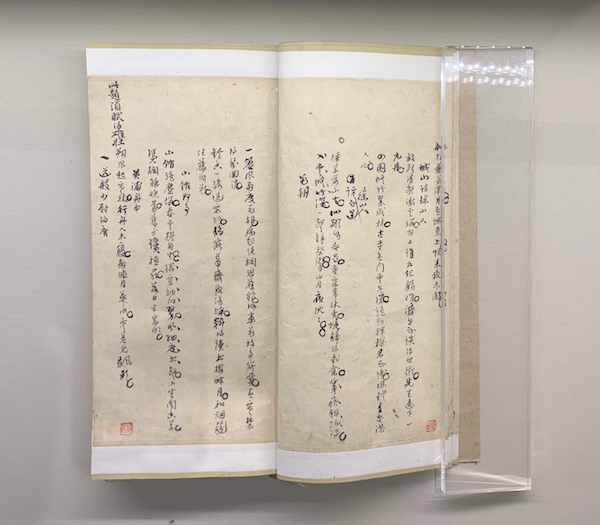
Wu Changshuo’s First Poem Collection —— Early Grass in the Red Papaya Pavilion

Wu Changshuo, Self-Written Portrait (Axis), 1923, (Anji) Wu Changshuo Memorial Collection.
The exhibition "Jin Shi Li Cao Mu Xin-Wu Changshuo and Shanghai" will be held until May 5th.